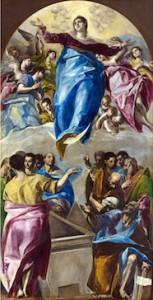JUNE 16, 2014 / WILLIAM NEWTON

“The Assumption of the Virgin” by El Greco (c. 1577-1579) The Art Institute of Chicago
This weekend while reading a book about the development of the major art museums which we enjoy in America today, I was struck by something which always bothers me about the nature of the institution of the art museum itself. Many of the objects we see on these shores were purchased by the American nouveaux-riches to give themselves some polish, so as to make up for the smell of their very new money. They went about despoiling European churches, convents, and residences of spiritual objects to use as status symbols or expensive playthings, in a millionaires-only game where religious institutions lost out to profane ones..
For example as the Impressionist painter Mary Cassatt went about aiding the Havemeyers, a sugar baron and his society wife, over the course of several years in seeking out and purchasing a work by El Greco, there was a noticeable lack of interest both on the part of her patrons and of Cassatt herself regarding the religious aspects of the pictures under consideration. In a letter to Mrs. Havemeyer, Cassatt describes a 13-foot-tall altarpiece of the Assumption of the Virgin by El Greco, which the Havemeyers were considering buying but which was too tall to fit inside their Fifth Avenue mansion [N.B. the piece later ended up in the Art Institute of Chicago.] In writing about it Cassatt notes nothing about the theological truths or spiritual virtues contained in the painting, but rather concentrates on the brushwork, the lines, and gives her verdict that it would be a good buy because the image of the Blessed Mother featured “a good head.”
If that’s all there was to recommend it, wouldn’t such a painting have been better-off being left in the church for which it had been painted? The counter-argument is, of course, that many objects such as these are better-preserved and cared for in museums, than they would have been had they been left in situ; in many cases such an argument is correct. However, I can’t help but feel that the forest is being lost for the trees, in such an argument.
A similar back-and-forth over artistic merit (and price) went on over the purchase of two of Raphael’s celebrated devotional images of the Blessed Mother and the Christ Child, acquired by J.P. Morgan for the Morgan Library. The issue in obtaining them was never about what such images of the Madonna and Child were supposed to teach the believer about the Incarnation. Rather, the goal was to see how much Morgan could show off, when he would hold meetings with these private devotional paintings hanging on the wall: a more expensive versions of deer heads stuffed and mounted following a successful hunt.
Sometimes the unwillingness or inability of many of our great museums to wade into issues of Catholic theology – since the overwhelming majority of Christian sacred art in American art museums is Catholic in origin – is almost embarrassing, at times. Placards and catalog entries go into raptures over color choices and brushstrokes, linear perspective and chiaroscuro, and say little about the theology portrayed – often getting it wrong when they do. Images before which generations of people brought their hopes and fears, to help them focus in their prayer life with God, are admired not for their ability to move the viewer to piety, but because of how bright the blue is, or how skillfully the tiny landscape behind the holy figures one is supposed to be concentrating on is painted. There is a pointless superficiality and emptiness in this sort of collecting. It is as if one was allowed to walk into the butcher’s shop and admire the marbling and the trimming of all of the fine steaks on display in the case, but one was never allowed to actually eat any of them.
This is not to say that one can never admire or appreciate an art object for its own intrinsic beauty. However when it comes to the sacred art of the West, created by centuries and centuries of Catholics, the danger of allowing a secular museum to tell you what you ought to think about such objects lies in forgetting to question those secular shrines, and assuming their neutrality. In realizing that profane institutions have many merits, but they are not the most trustworthy of guides, the smart museum visitor is the better-prepared visitor. Learn what you can from these sources, but make sure you take their pronouncements about the art you see with some reservations.
ABOUT THE AUTHOR
Wiliam Newton is a graduate of the Georgetown University School of Foreign Service, The University of Notre Dame Law School, and Sotheby’s Institute of Art in London. He lives in Washington, D.C. Learn more at wbdnewton.com and follow on Twitter @wbdnewton

